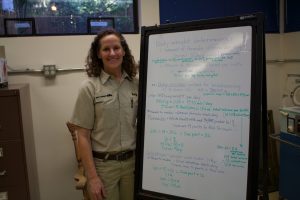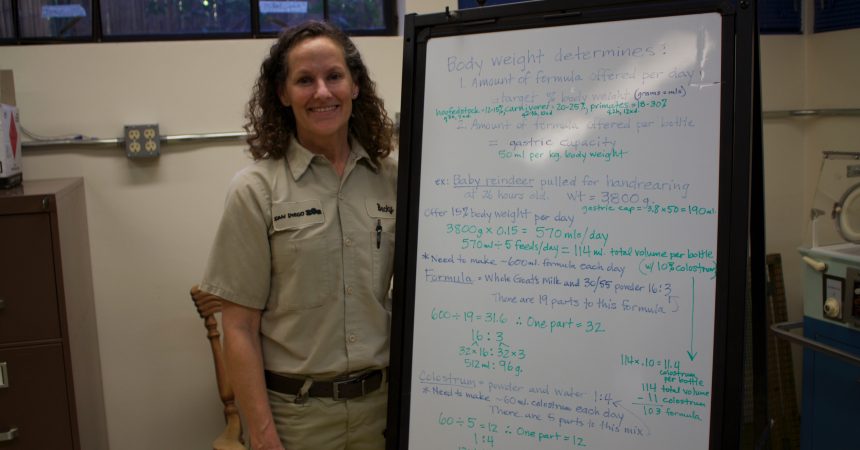Zoo InternQuest is a seven-week career exploration program for San Diego County high school juniors and seniors. Students have the unique opportunity to meet professionals working for the San Diego Zoo, Safari Park, and Institute for Conservation Research, learn about their jobs and then blog about their experience online. Follow their adventures here on the Zoo’s website!
 Watching fluffy Pallas’s cat kittens take their first steps. Mixing up the perfect formula to nourish a newborn Speke’s gazelle. Helping a baby gorilla bond with her mother. Sounds like a dream, right? For San Diego Zoo Keeper Becky Kier, it’s all in a day’s work at the Neonatal Assisted Care Unit (NACU).
Watching fluffy Pallas’s cat kittens take their first steps. Mixing up the perfect formula to nourish a newborn Speke’s gazelle. Helping a baby gorilla bond with her mother. Sounds like a dream, right? For San Diego Zoo Keeper Becky Kier, it’s all in a day’s work at the Neonatal Assisted Care Unit (NACU).
The NACU, or Nursery, is where the Zoo’s newest arrivals often receive a helping hand in their first few days or weeks of life. Whether newborn animals arrive in the NACU’s care due to injury or infection at birth, maternal neglect, maternal death, abuse by other animals, or an insufficient milk supply from their mother, these little ones are able to receive all the care and nurturing they need without ever having to leave the Zoo. As Ms. Kier knows, though, it’s not all just cuddling baby animals, through that’s definitely a perk of the job! There’s a very serious side to the NACU’s work in regards to conservation.
At the Zoo, the vast majority of its animal residents are endangered, meaning that the future existence of their species is at risk due to a multitude of reasons including climate change, loss of habitat, or other man-made problems. Newborns of endangered species, then, are far more than simply the new, furry faces on the block – they represent hope for the survival of their species as a whole. Every baby animal plays a critically important role in helping their endangered species’ population to rebuild and return to stability. First, these babies have to grow up healthy and strong – and that’s where the NACU steps in. By giving newborn animals their best start possible in life, Ms. Kier and her dedicated team are doing their part to help these animals become the capable adults that can really help their species thrive.
The NACU also plays an important role in preparing an animal for its future at the Zoo. Based on feedback from other members of Zoo staff, including keepers and veterinarians, the NACU can alter the type of care a baby animal receives. For example, an animal’s fitness, or ability to produce offspring, may determine that it will one day become part of the Zoo’s breeding program. An animal that is part of this program will play a large part in conservation as it will help to diversify the species’ gene pool in managed care. Another path that a Nursery ‘graduate’ may take is that of an Animal Ambassador. Animal Ambassadors can be found all over the Zoo featuring in interactive presentations, helping to teach conservation messages to guests, and showing off their many talents and abilities. While Animal Ambassadors sadly cannot talk, they truly do become a voice for their species and help people to understand the kinds of incredible animals we’ll be losing if we don’t make conservation a top priority in our lives.
Clearly, Ms. Kier and her team have a very important job helping zoo babies start off on the right foot. The rest of us, though, have the equally important responsibility of making sure these animals and all are others around the globe are able to live healthy, productive lives. How can we do this? By taking care of the environment, of course! The great news is that you’re already starting your journey to become a wildlife hero just like Ms. Kier. Becoming aware and knowledgeable of conservation issues is the first step in taking action to protect and preserve wildlife, so by reading this blog post, you’ve already started. Go you! Don’t stop here, though – take the time to learn about the issues impacting our environment and wildlife. The more you know, the more you can help.
Next, take a look at your everyday routine. Ask yourself, what are some simple ways I can be more Earth-friendly? Perhaps it’s by starting a family compost bin, or maybe it’s by making sure all the paper products you buy are Forest Stewardship Council approved, meaning they were created sustainably. What about cutting back on using throwaway products like plastic straws? The most important thing is, once you start incorporating more sustainable practices into your lifestyle, keep going! Living an environmentally friendly life is truly the best way you can be an advocate for our Earth and its incredible animals. While we can’t all be the baby animal whisperer extraordinaire that Ms. Kier is, all of us can and must step up and become the conservation superheroes our world needs.
Allison, Conservation Team
Week One, Spring Session 2018


